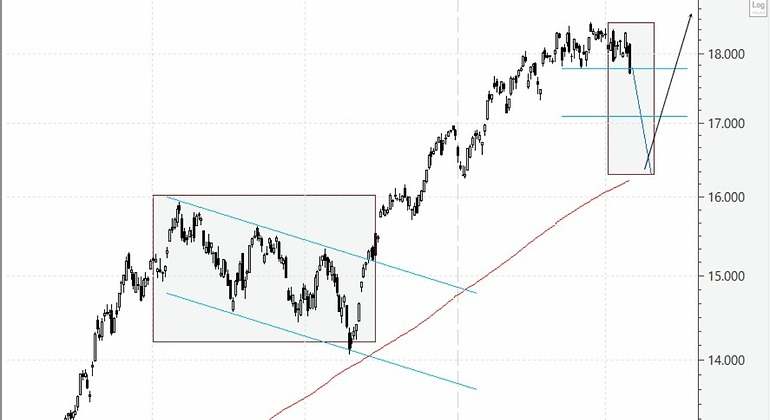The Asian stock market recorded its worst session since August of last year. And the European futures market anticipates another day of strong cuts. In addition to the tension in the Middle East, the irregular economic data from the Asian giant also contributed to the uncertainty of its recovery which seems to remain unstable.
Furthermore, in the United States, the retail sales data weighed heavily, which were better than expected by the market, gearing up for a more prolonged period of restrictive monetary policy in the country. This affected Wall Street during the session last Monday, when the European market was already closed. “It’s a perfect storm. Solid data in the US, bond market uncertainty, risk of miscalculation, and escalation in the Middle East,” explained IG analyst Tony Sycamore.
From a technical analysis standpoint, European indices have been subject to the performance of the US stock market. In particular, the Nasdaq 100 has positioned itself as the leader of the stock market in recent months thanks to companies like the ‘Fab Five’.
To date, the Wall Street technology index has been responsible for holding up global stock market gains. However, its recent weakness now signals a possible correction in the market. After dropping below 17,800 points in the last session, a bearish trend towards 17,100 points gains momentum.

“The loss of this reference opens the door to falls that could target the 17,100-16,680 point range, where I would be in favor of buying technology again,” explained Ecotrader technical advisor Joan Cabrero. “The alternation rule hints at a potential drop that would be quick and intense, not like the sideways downtrend we saw in the middle of last year that lasted three months,” the expert clarified.
Record highs in US-Germany risk premium
The benchmark of government bond markets, the 10-year US bond, yields over 4.6%, levels not seen since last year. In fact, so far this year, the yield of these sovereign debt securities has increased more than that of their counterparts in Germany, the UK, Switzerland, or Spain.
Selling pressure is mounting in the fixed income market due to the tension in the Middle East. However, what truly sets US bonds apart from the rest of the sovereign debt is the divergence between the Federal Reserve and the European Central Bank. While interest rate cuts are expected to start in the eurozone from June, they are currently ruled out in the United States.
With the German bund at 2.43% and the US bond at 4.6%, the spread between them (risk premium) exceeds 220 basis points at its highest level since late 2019.
Market volatility is driving gold and the dollar to record levels, as investors favor them as safe-haven assets amid the tension in the Middle East and the selling pressure in both the bond and equity markets. In fact, the dollar is up by almost 4% against the euro so far this year also due to the expectation of interest rate cuts anticipated in the eurozone against the Federal Reserve’s hold stance in the United States.
Gold has risen by over 15% this year to reach historic levels, above $2,380 per ounce. There are already forecasts predicting gold surpassing the $2,500 mark. Some even see the precious metal reaching $3,000. This is the case with Citi, where they believe that central bank purchases and ongoing conflicts heighten investor fears.


